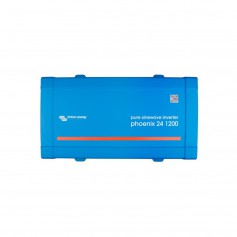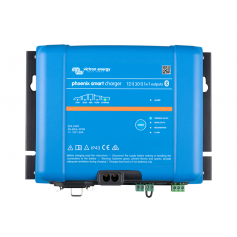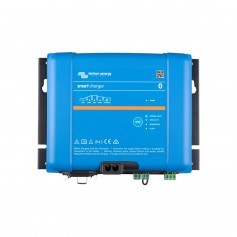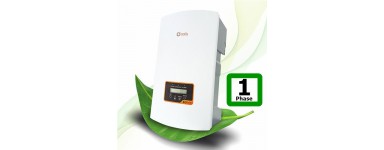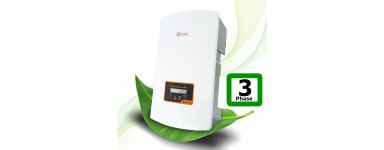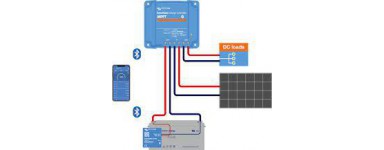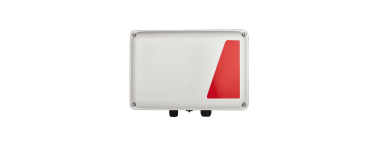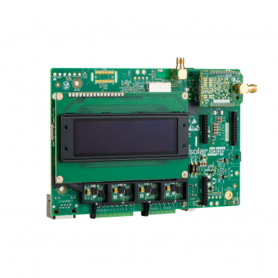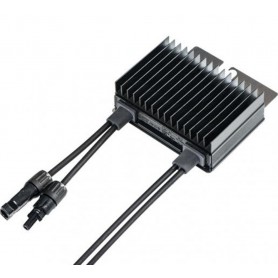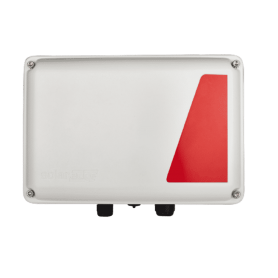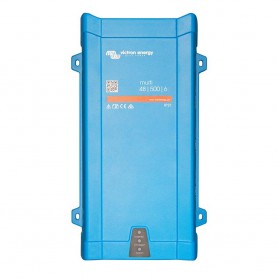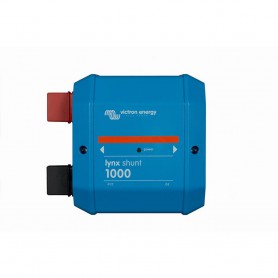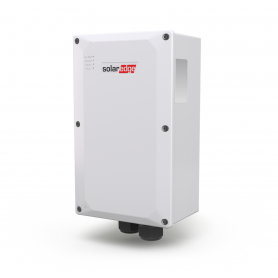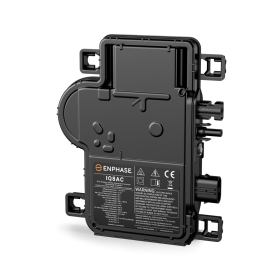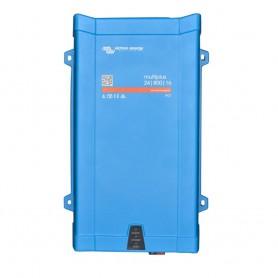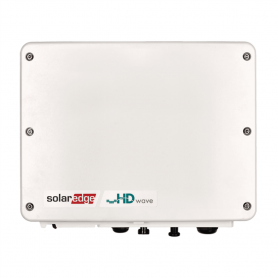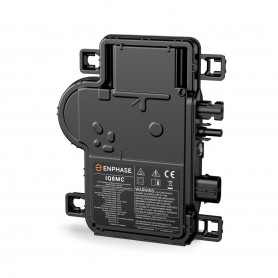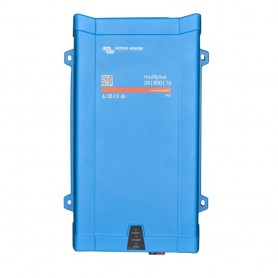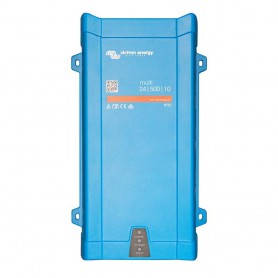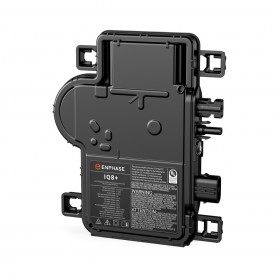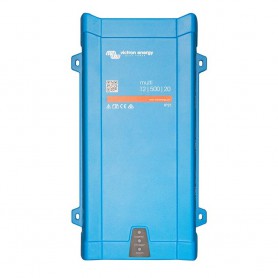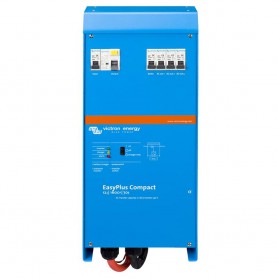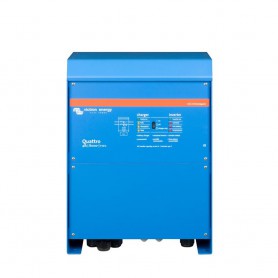No products
Filters
Solar InvertersThere are 216 products.

A solar inverter is a device that converts the direct current (DC) generated by solar panels into alternating current (AC) used by electrical appliances in households. Solar inverters are essential for any solar energy system, as they convert the power from the solar panels into a form that can be used by electrical appliances.
There are two main types of solar inverters: grid-tie inverters and off-grid inverters. Grid-tie inverters are connected to the grid and feed the power generated by the solar panels back into the grid. Off-grid inverters are not connected to the grid and feed the power generated by the solar panels on batteries.
Grid-tie inverters are the most common type of solar inverters. They are easy to install and maintain, and they are relatively affordable. Off-grid inverters are more expensive than grid-tie inverters, but they offer the advantage that they also work when the power grid fails.
The choice of a solar inverter depends on a number of factors, including the size of the solar power system, the location of the system, and the need for backup power. If you're considering a solar system, it's important to talk to a qualified installer to choose the best inverter for your needs.
Here are some of the most important factors to consider when choosing a solar inverter:
- Size of the solar power system: The size of the solar energy system determines the size of the inverter you need. A smaller solar power system needs a smaller inverter than a larger solar power system.
- Location of the solar power system: The location of the solar power system can also affect the type of inverter you need. If your solar system is located in an area with a lot of shade, you may need an inverter with a higher efficiency.
- Need for backup power: If you need backup power, you need an inverter designed to work with a battery.
If you're considering a solar system, it's important to talk to a qualified installer to choose the best inverter for your needs.
Subcategories
-
Single phase inverters
Single phase inverters are the most common type of solar inverters. They are designed to work with a single-phase power grid, which means that they convert only one phase of alternating current (AC) to direct current (DC). Single phase inverters are ideal for smaller solar power systems, such as those for homes or small businesses.
Single phase inverters are relatively affordable and easy to install. They are also very efficient, so they lose little energy during the transformation process. Single phase inverters are a good choice for people who are looking for an affordable and efficient way to connect their solar energy system to the power grid.
Here are some of the advantages of single-phase inverters:
- Affordable: Single phase inverters are relatively affordable, making them a good choice for those on a budget.
- Efficient: Single phase inverters are very efficient, so they lose little energy during the conversion process.
- Easy to install: Single phase inverters are easy to install, making them a good choice for people who want to install their solar power system themselves.
Here are some of the disadvantages of single-phase inverters:
- Less power: Single-phase inverters have a lower power than three-phase inverters, making them unsuitable for large solar power systems.
- Less flexible: Single-phase inverters are less flexible than three-phase inverters because they can only be used with a single-phase power grid.
If you're considering a solar power system, it's important to determine if a single-phase inverter is right for your needs. If you have a small solar power system and are looking for an affordable and efficient solution, then a single-phase inverter is a good choice. However, if you have a large solar system or need a more flexible solution, then you may need to consider a three-phase inverter.
-
3 phase inverters
A three-phase inverter is a device that converts direct current (DC) into three-phase alternating current (AC). Three-phase inverters are often used in large solar power systems, such as those for commercial buildings or industrial companies.
Three-phase inverters are more efficient than single-phase inverters, so they lose less energy during the conversion process. Three-phase inverters are also more powerful than single-phase inverters, making them suitable for larger solar power systems.
Here are some of the advantages of three-phase inverters:
- Higher efficiency: Three-phase inverters are more efficient than single-phase inverters, so they lose less energy during the conversion process.
- Higher power: Three-phase inverters are more powerful than single-phase inverters, making them suitable for larger solar power systems.
- More flexibility: Three-phase inverters are more flexible than single-phase inverters because they can be used with a wide range of solar power systems.
Here are some of the disadvantages of three-phase inverters:
- More expensive: Three-phase inverters are more expensive than single-phase inverters.
- Harder to install: Three-phase inverters are more difficult to install than single-phase inverters.
If you're considering a solar power system, it's important to determine if a three-phase inverter is right for your needs. If you have a large solar power system and are looking for an efficient and powerful solution, then a three-phase inverter is a good choice.
-
Hybrid Inverters
A hybrid inverter is a device that converts the direct current (DC) generated by solar panels into alternating current (AC) used by electrical appliances in households. Hybrid inverters are also able to store electricity from the grid in a battery and use that stored energy when the solar panels don't generate enough power.
Hybrid inverters are a good choice for people looking for a way to integrate their solar power system with their existing power grid. Hybrid inverters can help reduce your electricity bill and can also provide backup power in the event of a power outage.
Here are some of the advantages of hybrid inverters:
- Savings on your electricity bill: Hybrid inverters can help you reduce your electricity bill by feeding the power generated by your solar panels back into the grid.
- Backup power: Hybrid inverters can provide backup power in the event of a power failure by using the power stored in the battery.
- Flexibility: Hybrid inverters are more flexible than traditional inverters because they can be used with a wide range of solar power systems.
Here are some of the disadvantages of hybrid inverters:
- More expensive: Hybrid inverters are more expensive than traditional inverters.
- Harder to install: Hybrid inverters are harder to install than traditional inverters.
If you're considering a solar system, it's important to determine if a hybrid inverter is right for your needs. If you're looking for a way to integrate your solar system with your existing grid and you want to save on your electricity bill and protect your home from power outages, a hybrid inverter is a good choice.
-
Communication and surveillance
Solar energy communications and monitoring are systems used to monitor and control solar energy systems. These systems can be used to monitor the performance of the solar power system, detect any problems and control the system remotely.
Different types of solar communications and monitoring systems are available, each with its own unique characteristics. The most common types of systems are:
- Local monitoring system: This type of system uses a local monitor to track the performance of the solar power system. The monitor is usually installed near the solar power system and can be used to view data about the performance of the system, such as the amount of energy generated, the temperature of the solar panels and the status of the inverter.
- Remote monitoring system: This type of system uses an internet connection to monitor the performance of the solar power system. The system can be controlled from anywhere with internet access and can be used to view data about the performance of the system, such as the amount of energy generated, the temperature of the solar panels, the status of the inverter and any problems with the system.
- Combined monitoring system: This type of system combines the functions of a local monitoring system and a remote monitoring system. The system can be used to view data about the performance of the system, such as the amount of energy generated, the temperature of the solar panels, the status of the inverter and any problems with the system.
Solar communication and monitoring systems can be used to improve the performance of your solar power system, detect any problems, and control the system remotely. If you're considering a solar system, it's important to choose one that suits your needs.
-
Solar Interface

A solar optimizer is a device used in a solar energy system to improve the efficiency of the solar panels. Optimizers are placed between the solar panels and the inverter, and they ensure that each solar panel operates at its maximum power, regardless of the shade or other factors that can affect the performance of a solar panel.
Optimizers can improve the yield of a solar energy system by 10-20%. They can also extend the life of the solar panels by regulating the temperature and stabilizing the voltage.
Optimizers are a good choice for solar system owners who want to get the most out of their investment. They can also be a good choice for solar system owners who are dealing with shade or other factors that can affect the performance of their solar panels.
Here are some of the benefits of using solar optimizers:
- Increased efficiency: optimizers can improve the yield of a solar energy system by 10-20%.
- Optimized performance: Optimizers ensure that each solar panel is operating at its maximum power, regardless of shade or other factors that can affect a solar panel's performance.
- Extended service life: optimizers can extend the life of the solar panels by regulating the temperature and stabilizing the voltage.
- Enhanced monitoring: Optimizers offer comprehensive monitoring capabilities, allowing solar system owners to track their system's performance and identify any issues.
If you are considering installing a solar power system, it is advisable to consider using optimizers. Optimizers can help you get the most out of your investment and keep your solar system performing at its best.
-
Optimizers
-
Microinverters
Solar microinverters are small electronic devices that convert the direct current (DC) electricity produced by individual solar panels into alternating current (AC) electricity. This AC electricity can then be used to power your home or business, or sold back to the grid.
Solar microinverters are a relatively new technology, but they have become increasingly popular in recent years. This is due to several advantages they offer over traditional string inverters.
Advantages of solar microinverters:
- Increased energy production: Solar microinverters can maximize energy production by converting the DC electricity from each solar panel independently. This means that the overall performance of the solar system is not affected by the weakest panel.
- Improved shading performance: Solar microinverters can operate effectively in shaded conditions. This is because they can convert the DC electricity from each panel independently, even if some of the panels are shaded.
- Greater safety: Solar microinverters operate at a low voltage, which makes them safer than traditional string inverters. This is because there is less risk of electric shock if there is a fault in the system.
- Easier installation: Solar microinverters are generally easier to install than traditional string inverters. This is because they are smaller and lighter, and they can be mounted directly to the solar panels.
Disadvantages of solar microinverters:
- Higher cost: Solar microinverters are more expensive than traditional string inverters. This is because they are more complex to manufacture and install.
- More components: Solar microinverters require more components than traditional string inverters. This can make the system more complicated and more likely to fail.
Overall, solar microinverters are a promising technology that can offer several advantages over traditional string inverters. However, they are also more expensive and more complex.
Here are some of the leading solar microinverter manufacturers:
- Enphase Energy
- SolarEdge Technologies
- SMA Solar Technology AG
- Hoymiles Power Electronics Inc.
- Chilicon Power Electronics Corp
-
-
-
-
 Sale!In Stock = 1x
Sale!In Stock = 1x -
-
-
Victron Energy MultiPlus 24/1600/40-16 VE.Bus
Pre-order! Be the first in line to receive this product. When item is on stock we will serve the already placed orders first. -
 Sale!In Stock = 22x
Sale!In Stock = 22x -
 Sale!In Stock = 15x
Sale!In Stock = 15x -
-
Victron Energy Multi 48/500/6-16
Pre-order! Be the first in line to receive this product. When item is on stock we will serve the already placed orders first. -
-
-
Victron Energy MultiPlus 24/1200/25
Pre-order! Be the first in line to receive this product. When item is on stock we will serve the already placed orders first. -
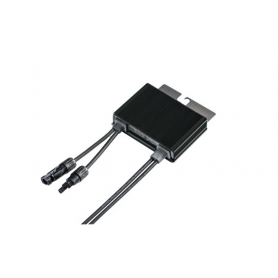 Sale!In Stock = 148x
Sale!In Stock = 148x -
-
Victron Energy MultiPlus 24/800/16-16
Pre-order! Be the first in line to receive this product. When item is on stock we will serve the already placed orders first. -
 Sale!In Stock = 9x
Sale!In Stock = 9x -
 Sale!In Stock = 18x
Sale!In Stock = 18x -
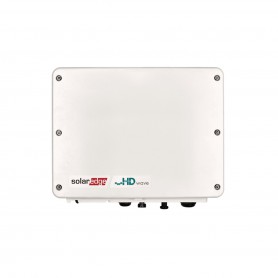 Sale!In Stock = 7x
Sale!In Stock = 7x -
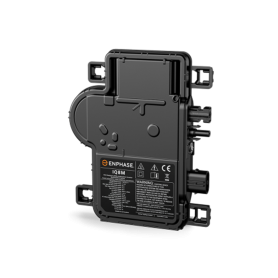 Sale!Out of stock
Sale!Out of stock -
Victron Energy Multi 24/500/10-16
Pre-order! Be the first in line to receive this product. When item is on stock we will serve the already placed orders first. -
 Sale!In Stock = 9x
Sale!In Stock = 9x -
-
Victron Energy Multi 12/500/20-16
Pre-order! Be the first in line to receive this product. When item is on stock we will serve the already placed orders first. -
-
 Sale!In Stock = 19x
Sale!In Stock = 19x -
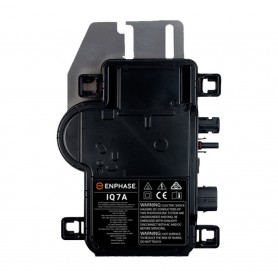 Sale!Pre-order! Be the first in line to receive this product. When item is on stock we will serve the already placed orders first.
Sale!Pre-order! Be the first in line to receive this product. When item is on stock we will serve the already placed orders first.Enphase IQ7A 60 / 72 Cell Microinverter 230VAC
Pre-order! Be the first in line to receive this product. When item is on stock we will serve the already placed orders first. -
Victron Energy Easy Plus Compact 12/1600/70-16
Pre-order! Be the first in line to receive this product. When item is on stock we will serve the already placed orders first. -
 Sale!In Stock = 5x
Sale!In Stock = 5x -
 Sale!In Stock = 352x
Sale!In Stock = 352x -
Victron Energy Quattro 48/8000/110-100/100
Pre-order! Be the first in line to receive this product. When item is on stock we will serve the already placed orders first.
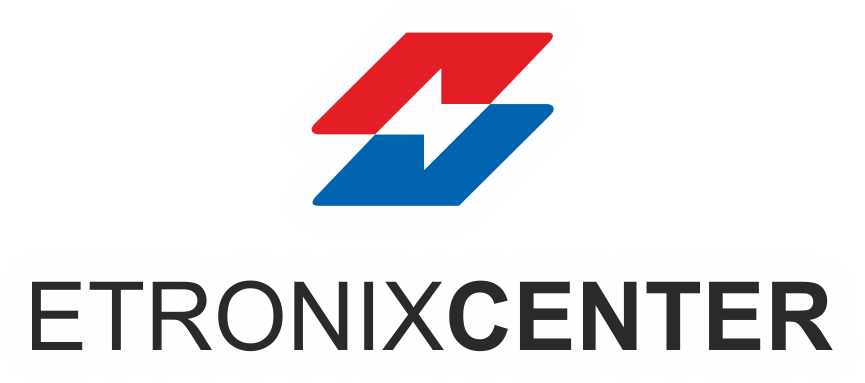
 en
en
 nl
nl  de
de  fr
fr  es
es  it
it 



























 United States.
United States.

